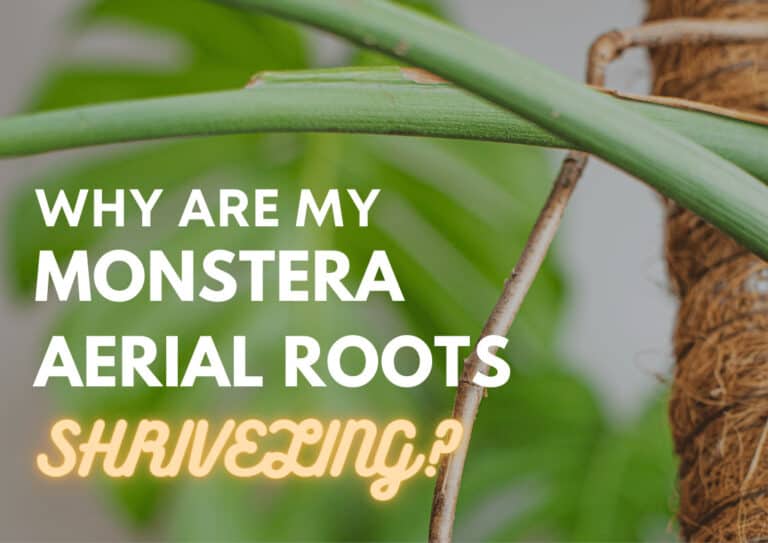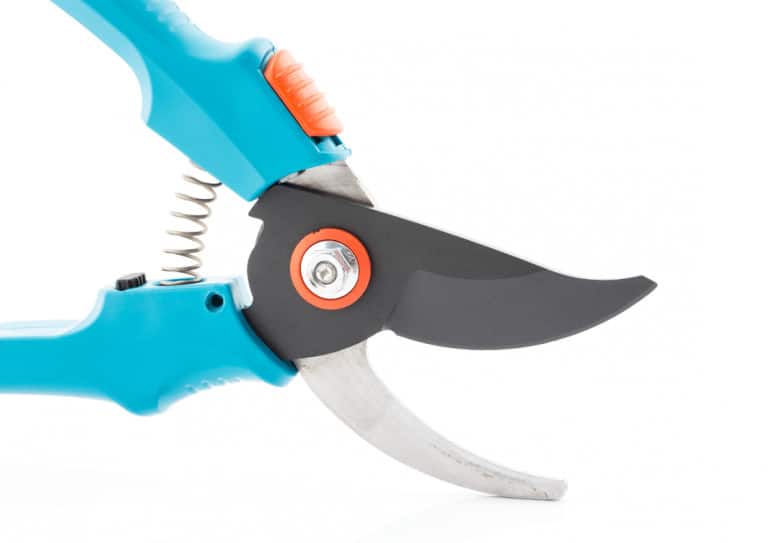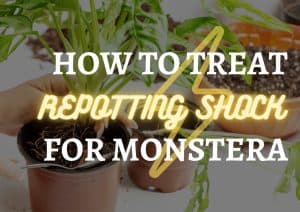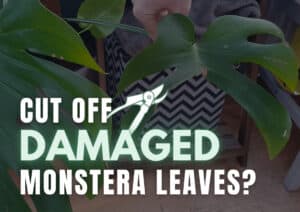Why Are My Monstera Aerial Roots Shriveling?
-
Chris Dosser
- February 10, 2022
If you buy something using the retail links in our articles, sometimes we earn a small affiliate commission. This does not impact the products we recommend.
Monstera aerial roots may shrivel up for a number of reasons. Fortunately, none spell certain doom for the plant itself.
Shriveling aerial roots is not a sure sign of moisture problems by itself. If your Monstera’s aerial roots are drying out because of a lack of moisture, you will also see signs of dehydration in the plant’s foliage or stem.
The most likely cause of Monstera aerial roots shriveling and drying up is physical damage. This damage could be so minute that it’s invisible to the naked eye. Monitor your Monstera for additional symptoms of disease or malnutrition. But, more often than not, you’ll find that the shriveled root is quickly replaced by perfectly healthy ones.
While shriveling aerial roots are rarely cause for concern, they can sometimes be the result of root rot. Aerial root rot is distinguished by root tissue that is shriveled and soft (versus dry and hard).
Caring for Monstera aerial roots is a bit different than those beneath the soil. But that doesn’t mean it’s any harder.
All you need are the answers to a few simple questions to successfully cultivate this houseplant and its airborne roots:
- Why do Monstera produce aerial roots?
- What is aerial root rot?
- Should I mist my Monstera’s aerial roots?
- Can I prune Monstera aerial roots?
- How do I train Monstera aerial roots?
One common misconception about Monstera aerial roots is that they can be cut and propagated (grown into clones of the parent plant). Unlike the rhizomatic stems of spider plants, your Monstera will not produce babies from its aerial roots. You can, however, propagate Monstera from other cuttings by following our step-by-step guide.

Why do Monstera produce aerial roots?
Your potted Monstera may not have much use for those aerial roots. But the reason they exist becomes incredibly clear when you learn how Monstera grow in the wild.
In their native rainforests, Monstera are epiphytes. Epiphytes are plant species that grow on other plants, relying on them for support and (in some cases) nutrition.
To put it simply, you could say wild Monstera grow as vines. They climb up large tree trunks in order to reach as much sunlight as possible despite growing beneath the dense forest canopy.
Aerial roots are what allow Monstera plants to adhere themselves to various tree trunks. These roots also help provide water and nutrition to the length of the plant. (The underground roots of a mature Monstera may be several meters below the bulk of its foliage.)
Our Favorite Monstera Plants And Supplies On Etsy
What is aerial root rot?
Avid gardeners are all too familiar with the plant killer known as root rot. This condition is most often caused by excess moisture. And it doesn’t just affect roots growing underground.
The good news is that aerial root rot is a lot easier to identify and diagnose than traditional root rot.
The most common sign your Monstera is experiencing aerial root rot is the presence of soft or mushy roots. In cases where the roots have been rotting for a while, you may notice a bad odor.
Treating aerial root rot is often as simple as removing the affected growth. However, the rot is likely to return if you don’t address the root cause (no pun intended!).
Since aerial root rot is a result of too much moisture, you should take a good, hard look at your watering habits.
Watering Monstera aerial roots directly is often to blame for this condition. Humidity levels above 70% can also cause aerial root rot.
In some cases, aerial root rot is secondary to root rot occurring below the soil’s surface. This type of root rot can quickly kill the plant itself, so it’s a good idea to take a peek at your Monstera’s underground root system as well.
Should I mist my Monstera’s aerial roots?
Many home gardeners opt to mist the aerial roots of their Monstera. But whether or not this actually benefits the plant is up for debate.
If you struggle to maintain adequate humidity levels in your home, occasional misting may help supplement your Monstera’s moisture needs. This should be done no more than once a week. Keep an eye out for signs of excess moisture, including aerial root rot.
Meanwhile, some Monstera enthusiasts believe that misting actually contributes to shriveled aerial roots. The theory is that, while misting does raise the ambient moisture level temporarily, it ends up pulling moisture out of the roots in the long run.
While misting Monstera aerial roots is considered okay on a case-by-case basis, placing the roots directly in water is not recommended. Submerging aerial roots in water will quickly lead to root rot, and won’t notably increase your Monstera’s water uptake anyway.

Can I prune Monstera aerial roots?
Pruning aerial roots won’t affect the plant’s health positively or negatively.
Use a sharp, clean set of shears to remove unwanted root tissue. Do not cut into the node (thick sections of stem where aerial roots emerge from).
Some gardeners believe that shriveled aerial roots should be removed so the Monstera can redirect energy to producing new, healthy growth. If you leave shriveling roots intact, they will eventually fall off on their own.
Cutting off healthy Monstera aerial roots is generally an aesthetic choice. Just keep in mind that your Monstera will probably shoot out more aerial roots in place of the ones you trim off.
How do I train monstera aerial roots?
Rather than trimming back Monstera aerial roots, you can instead use them to your advantage. The best options for training Monstera aerial roots are to attach them to a support or place them in soil.
Training your Monstera aerial roots to climb up a support system is a great way to mimic the plant’s natural growth habits. Moss poles are the preferred supports for potted Monstera.
When training an indoor Monstera to climb, be wary of placing it too close to a wall or piece of furniture. While rare, there’s a chance that your Monstera will grab onto these structures with its aerial roots. This can make moving the plant without damaging it extremely difficult.
Longer aerial roots can be gently trained down into the soil. Doing so creates a tidier-looking plant and offers a bit of extra support for the Monstera’s stems.
Young roots — those that have not yet turned woody — are ideal for training into the soil as they are flexible and more likely to adapt to life underground.
Take home message
As far as houseplants go, it’s hard to beat the lush beauty of Monstera. One of the main reasons for Monstera’s immense popularity is how low-maintenance it is — aerial roots being no exception.
Dry, shriveled aerial roots are nothing to worry about as long as the rest of your Monstera is thriving. Meanwhile, aerial roots that have gone soft or give off a foul smell are a likely sign of root rot.
You can carefully remove shriveled aerial roots with a sharp blade or allow them to fall off naturally. There’s no need to mist or water your Monstera’s aerial roots if the underground roots receive adequate moisture. Rather, unnecessary watering is a leading cause of aerial root rot.

Chris Dosser
Co-Founder of Eden Indoors
Chris is a self-taught horticulturist with over a decade of experience caring for houseplants and creating lush, thriving indoor oases. He specializes in Monstera, and by self admission has a serious problem with buying and propagating rare indoor plants!
Similar Posts
Monstera Repotting Shock (Plant First Aid)
Repotting shock is worrying to witness. What should you do when your Monstera plant's leaves turn yellow and droop after it is repotted?
Should I Cut Off Damaged Monstera Leaves?
Damaged Monstera leaves can ring alarm bells for plant owners. Should you cut them off, or will that do more harm than good to the plant?



